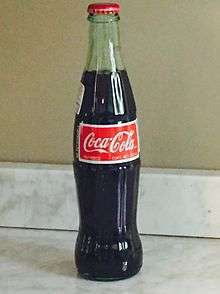Mexican Coke

In the United States of America, Mexican Coke (Spanish: Coca Cola de México) or, informally, "MexiCoke",[1] refers to Coca-Cola produced in and imported from Mexico.[2]
Although intended for consumption in Mexico, Mexican Coca-Cola has become very popular in the United States because of a flavor that Coca-Cola fans call "a lot more natural tasting".[2] While many believe the primary difference in flavor between Mexican Coca-Cola and the American Coca-Cola formula is that Mexican Coke is sweetened using cane sugar as opposed to high-fructose corn syrup, a scientific analysis of Mexican Coke found no sucrose (standard sugar) in its sample of Mexican Coke, but instead found fructose and glucose levels similar to other soft drinks sweetened with high-fructose corn syrup.[3] Coca-Cola claims that Mexican Coke exported to the United States is made with cane sugar, while some Mexican bottlers may use high-fructose corn syrup for drinks intended for sale in Mexico.[4] Therefore, while Coca-Cola labeled "Mexican" in the U.S. is made with cane sugar, not all Coca-Cola sold in Mexico is.
History
Coca-Cola opened its first bottling franchise in Mexico in the 1920s with Grupo Tampico,[5] and then Grupo ARMA.[6] Monterrey-based FEMSA is currently the largest Coca-Cola bottler in Mexico, along with most of Latin America.

In 2013, a Mexican Coca-Cola bottler announced it would stop using cane sugar in favor of glucose-fructose syrup.[7] It later clarified this change would not affect those bottles especially exported to the United States as "Coca-Cola Nostalgia" products.[8]
Taste tests
Results from taste tests have been mixed. In a taste test conducted by a local Westchester, New York magazine, tasters noted that the Mexican Coke had "a more complex flavor with an ineffable spicy and herbal note",[9] and that it contained something "that darkly hinted at root beer or old-fashioned sarsaparilla candies".[9]
However, participants in a different double-blind taste test overwhelmingly preferred American Coca-Cola.[10] Participants in taste tests conducted by Coca-Cola reported no perceptible differences in flavor between American Coke and the Mexican formulation.[11]
Bottle
Mexican Coke is bottled in a thick 355 ml (12.0 US fl oz) or 500 ml (17 US fl oz) glass bottle, which some have described in contrast to the American Coke plastic bottles as being "more elegant, with a pleasingly nostalgic shape".[9] Instead of having a vinyl label wrapped around plastic, an enamel label is painted directly on the glass bottle. Most exporters of Mexican Coke affix a paper sticker containing the nutrition facts label, ingredients, and bottler and/or exporter's contact information, to meet U.S. food labelling requirements.
New Zealand
A similar phenomenon exists in New Zealand, where Coca-Cola is available both bottled locally (sweetened with sugar) and imported from the United States (with high-fructose corn syrup).[12]
See also
- Pepsi-Cola Made with Real Sugar, a line of Pepsi products flavored with cane sugar
References
- ↑ Phillips, Matt; Ferdman, Roberto A. (November 4, 2013). "A New Tax Might Cost Mexicoke Its Signature Sugar". The Atlantic.
- 1 2 Walker, Rob (2009-10-11). "Cult Classic". New York Times.
- ↑ Ventura, Emily E.; Davis, Jaimie N.; Goran, Michael I. (April 2011). "Sugar Content of Popular Sweetened Beverages Based on Objective Laboratory Analysis: Focus on Fructose Content". Obesity. 19 (4): 868–874. doi:10.1038/oby.2010.255. Retrieved 22 March 2013.
- ↑ Choi, Candice (Nov 6, 2013). "Mexican Coke in US Will Still Use Cane Sugar". Yahoo. Associated Press.
- ↑ James R. Davis, Adelaide B. Davis Effective training strategies 1998 p312 "The first Coca-Cola bottling company in Mexico, Grupo Tampico, with eighty-three years of history, operates a series of gas stations, computer stores, automotive retailers, hotels, and radio stations, and they still distribute Coca-Cola"
- ↑ Leendert Andrew de Bell Globalization, regional development and local response 2005 p68 "Starting out in the late 1920s as a small factory for ice cream and soft drinks, the company acquired one of Mexico's first franchises to bottle soft drinks under license of the Coca-Cola Company in the 1930s. In the following decades, operations ..."
- ↑ Latin Times Nov 04 2013 http://www.latintimes.com/mexican-coke-switching-corn-syrup-cane-sugar-4-reasons-why-shift-terrible-132544
- ↑ Associated Press November 6, 2013 http://news.yahoo.com/mexican-coke-us-still-cane-sugar-152028256.html
- 1 2 3 Sexton, Jule (2010-02-22). "Mexican Coke Hits the County: A Blind Taste Test". Westchester Magazine. Today Media, Inc.
- ↑ http://drinks.seriouseats.com/2011/09/the-food-lab-drinks-edition-is-mexican-coke-better-than-regular-coke-coke-taste-test-coke-vs-mexican-coke.html
- ↑ http://www.bloomberg.com/bw/articles/2013-11-11/the-mexican-coca-cola-myth-its-almost-american
- ↑ Steward, Ian (June 26, 2011). "American Coke fails Kiwi tastebud test". Stuff. Fairfax Media.
Further reading
- Melnick, Meredith (2010-10-28). Study: Hey, Hipsters, Mexican Coke Might Be a Myth". Time Magazine.